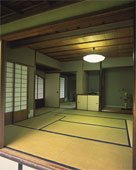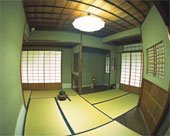The bed’s primary purpose is to serve an ESSENTIAL BIOLOGICAL FUNCTION which will influence our failure or success and our health and well being and how long we live and our quality of life.
Many people take the bed for granted, seeing it mostly as an object. Advertisers have little to say about it other than whether it is soft or stain resistant. It’s not that people don’t appreciate beds by any means, but we treat them like an automobile or wrench or some other machine or static tool.
Our bodies interact with the bed. The bed is a vehicle for rest, an instrument of peace and quiet, a place to ‘recharge our batteries’. The bed is a hang out for some of our favorite activities, a launching pad for nightly sleep and dreams, a place to recuperate from illness. When you think about it, life kind of begins and ends on a bed.
Like a bicycle which helps get us somewhere, the bed helps us stay somewhere. Designers have been overlooking the biological element for decades. What bed design would maximize the body’s restorative capabilities using knowledge of biology and particularly how to restore cellular energy and help us tap into our natural circadian rhythms? Technology has NOT improved the bed but actually hurt it by leaving out the primary purpose. (see The Ergonomics of Sleep)
The New Biology is a recent development that recognizes the cell as a microcosm of the organism. The cell is practically a living organism in many ways with it’s own life-force. Whatever hurts or helps the cell does the same for the organism in which the cell lives. The cell operates on a subtle electrical system, which becomes disrupted by synthetic materials. See the groundbreaking article ‘Naked Beneath Your Clothing”.
A mattress construction that promotes air flow and allows perspiration to evaporate helps our bodies cool or warm themselves and maintain homeostasis. This enhances the sleep cycles so we stay in the deeper Delta waves longer which provides maximum rejuvenation. Our bodies tune into natural circadian rhythms when presented with the right environment. This is where optimal rest and vitality can occur.
A simple pallet on the floor, if it is non-synthetic, is far better than the fanciest big fluffy synthetic bed you can find.
This is my list of aspects of a comfortable bed based on these principles:
- Firm as possible to facilitate optimal circulation and alignment.
- Breathable: air circulation from above and below. Natural fibers.
- Not a dust collector. Dust hampers sleep and health. Easy to move to get at dust if necessary.
- Not made of metal due to the amplifying effect of electromagnetic fields from floor, walls, ceiling, appliance, power lines and transformers. Bed should be wood. (Read this for an entire article on this aspect of sleep).
- Easy to make up. Since you do it every day. Process should be streamlined. Bedding articles should be simplified. The duvet is a great invention.
- Size matters. Not too big or too little. You don’t want to feel cramped but you don’t want to use extra floor space.
One day I decided I needed some extra space in my house and wondered if I should add on. Then I discovered a remarkable solution. I found a little corner which is the entryway/living room area. No-one was doing anything with it at night–save for maybe ghosts–and it was an exquisite sleeping spot, featuring full picture windows to the night sky and fresh air from the open door. To my surprise it was far better than my current bedroom. So with a little creativity and adaptability I was now proud owner of a larger house, in essence, even though I couldn’t really convince anyone of that.
My new bedroom was like Cinderella, it disappeared at a certain hour. But since it only takes three minutes to get out and make up, no problem–no longer than it took to make the bed anyway and leave it free standing.
Foor sleeping is a concept difficult for most Americans to grasp. So here are my thoughts on the subject.
There’s nothing wrong with filling up a room with a bed. It is such an important aspect of our lives, it deserves its own room. It creates the atmosphere of rest and is always ready for you to plop yourself down at a whim. Also, a true platform bed can be used as a couch or lounge chair, so it’s not exactly just taking up the space if it’s thought of in this way. It could be considered simply a raised floor, where you might sit to read or watch a video.
And of course there is the fold-away bed. But I have never found one that is comfortable as either a couch or a bed.
To the minimalist there is a problem with wasted space under the bed. This is easily solved by turning that area into a storage space. Something as simple as cardboard boxes can be very effective for storing clothes, books, or whatever (see photo). A more permanent solution would be wooden drawers or boxes.
However, if space is limited, the put-away, disappearing bed can have huge advantages. I have thoroughly tested the simple platform bed with underneath storage and the put-away, disappearing bed over many years thinking about which one I like the best. I personally think the put-away bed has huge overlooked advantages that most people don’t realize because they haven’t had the time or opportunity to try it.
Here are some advantages:
- You gain an ENTIRE extra room. That could be thousands of dollars depending on where you live. If you downright can’t afford an extra room then you have just upped your standard of living and quality of life exponentially–like getting a raise or promotion at work.
- Dust management extraordinaire. You don’t even KNOW how much dust can accumulate under a bed until you check every day. It only takes one day for a bed to collect dust underneath. Now some of us just don’t have those standards and it’s no big deal. But if you like to keep things clean, the put-away, disappearing bed is the ultimate. Carpets are dust’s best friend. They hide dust, dust mites, fleas, mold, etc. Not even the best vacuum cleaner and shampoo can deal effectively with carpets. All you have to do is look under one after a thorough cleaning to see what I mean. Carpets have got to be the worst design of the century. They trap dirt–and you can’t get to it. We are now finding that trapped dirt is a serious health hazard. They represent luxury but they are filthy. The put-away bed works best with a “shoes” free room or area. You will want to do a little dust mopping as part of the bed making ritual.
- Speed and ease of making the bed. I have analyzed this process with the eye of an engineer for several years now, listing each step of pulling the covers back, putting the pillows aside, brushing the sheets with the hands, assembling the sheets back to their proper neat and tight places and then the blankets, etc. It definitely helps to have a duvet/comforter instead of a pile of odd blankets. But the surprising discovery is that the average queen sized bed on frame takes no longer to make than the put-away, disappearing bed (that is, when each particular bed is optimized with the right bedding pieces.). The put-away disappearing bed has what seems like more steps. You have to put it away, and then take it out and make it. However, putting it away takes a matter of seconds. The futon and sheets and blankets go in a closet and the frame (modern tatami mat adaptation) leans up in two pieces against the wall. Total time averages around 2 minutes to break it apart and put it away, and about 3 minutes to get it out and put it together. That’s about the time to make the average bed. This is the biggest fear preventing people from adopting this method. The trick is to have the bed storage near where the bed will be located.
- One big advantage of the disappearing bed is the sheets get thoroughly shaken every day. With the standard western bed one typically brushes the sheets with the hands. This takes longer and isn’t nearly as effective as shaking in the air. Since dust does have to go somewhere – as anyone with out carpeting can plainly see – I highly recommend either a window or a high quality carbon air filter. This could clean the air of a small room within an hour. Other alternatives are–fresh air through the window (negative ions act like an air filter), spraying EM-1™ in the air with a squirt bottle, or burning a beeswax candle for about an hour in a small room (beeswax candles purify the air of dust and other toxins by emitting negative ions that react with the positively charged ions of dust). This may sound like overkill but keeping the dust level down will enhance sleep quality. If you do use a bed-frame, a dust skirt will certainly help. However, the anti-dust mite folks say not to have any cloth touching the floor so the dust mites can’t climb up.
- Air circulation above and beneath. That can be a drawback with sleeping on the floor. I have thoroughly tested different platforms and I personally notice a huge difference in sleep quality when air can go beneath the mattress/pad. The body respires, meaning it exchanges gasses with the environment. The skin is the largest organ of the body. It needs access to free flowing air to perform it’s job. Many people have told me they notice a huge improvement when switching from synthetic to natural mattresses and blankets/pillows. There is a feeling of warmth in the winter and coolness in the summer. (Synthetic, think plastic). But what about beneath the mattress/futon? That’s where the slatted bed-frame comes in for the western decorators, or the tatami mats for an Asian approach. A tatami mat is a thick, stiff reed mat about one inch thick. The futon goes on top of it and Wa La! you now have air circulation without a bed-frame. However, the traditional tatami mat has a major drawback–it collects dust and dust mites. You can’t wash it. So here is the solution–make a tatami mat out of wood–like a slatted futon frame but without the legs. The problem with this is that putting it away is a challenge. It is big and heavy which is why we need moving companies. So imagine that same frame is in two parts which are 30″ x 40″ each. Welcome to the EcoSquare™ which can be used with legs for a Platform Bedframe or withOUT legs for a modern tatami mat (or pallet on the floor)! Now there is no big thing to move and the two halves can be placed either on hooks or behind some other piece of furniture when not in use. (Note my solution–use the two halves as backrests for the Tilt Seats™ in the living room.)
-
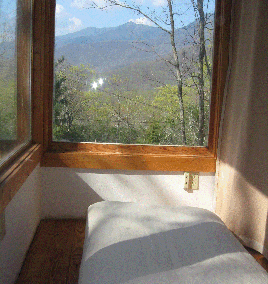
Durng the night: the EcoSquares™ and Wool/kapok Futon are laid out and curtain pulled. Usable floor space is 4' x 9'
-
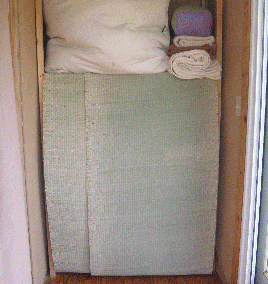
-
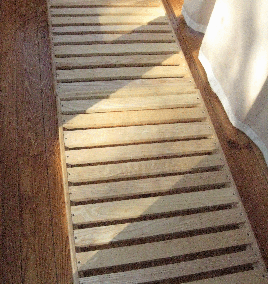
EcoSquares™-- modular slatted bed-frames act like tatami mats to create underneath ventilation.
-
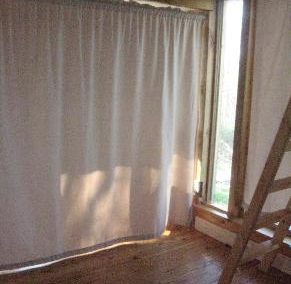
This is what it looks like on the other side of the curtain.
-

During the day, the bedroom becomes a living room. EcoSquares™ act like modern tatami mats or slatted bedframes at night when placed on the floor, and by day become backrests when tucked behind the Tilt Seats™. These 'tatami mats' are really the platform bedframe minus the legs which comes in two pieces for ease of moving.


